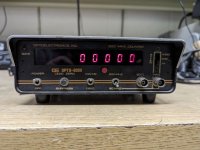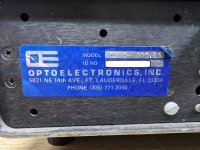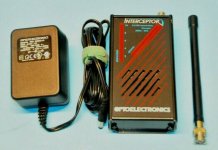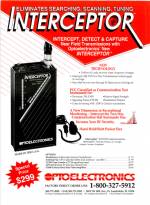So way back in the 1990’s there was a company in Florida called OptoElectronics that made some of the coolest toys for the scanner hobbyist. While the company is still around the toys they have appear rather pedestrian these days. This is a tale of some of the toys they came out with that I had and enjoyed.
I really got into computerized scanning. Mostly this entailed some sort of programming interface to the few scanners that supported it as SDR’s were not a thing then.
So one day I heard about the OptoElectronics OptoScan OS456, an interface one could install into a PRO2004, 2005 or 2006 scanner. This basically applied a serial port to the radio and allowed one to program the scanner from a PC. More importantly though it also allowed the use of programs like ScanCat or Probe. This was a game changer!
Probe especially worked great with the OS456. It was a DOS based utility (back in the days when Windows 3.11 was king, which was basically a shell run in DOS). I had an old DOS-only laptop that I used for Probe and it would site there and log activity for weeks at a time.
I set it up at work with my 2006 connected to a high-gain VHF antenna on a 100-foot tower scanning the VHF public safety freqs for a few weeks while I was on vacation. I was looking for a new frequency for our fire department so used the hit logs to find a lightly used frequency that met our needs; with no current licensees within 70 miles, minimal adjacent channel users and minimal activity from distant users so we wouldn’t get blasted every time the band opened. When I returned to work I went thru the logs and found a half dozen candidates, I culled them and programmed them in separately and let Probe scan them for another couple weeks. I then had my two final candidates, one of which was 151.010. I applied for a license for this for our FD and got it, this after the local APCO frequency coordinator said there would not be any VHF freqs available. This was still in the days when Highway, Forestry, Fire, Police etc. had their own frequency pools so I had to work with both IMSA (Fire) and AASTHO (Highway) to get this channel licensed as it was in the Highway pool.
Later I was looking for a 2-Meter frequency for a local ham club, again the local coordinators said there was nothing available on 2M or 440, he suggested 220 would be better. I found over a dozen repeater frequencies that had no activity for 2 months. These zombie repeaters had been coordinated for years but either never built, were off the air or had no users or even automatic ID’s for the entire period. While we were still denied a coordination we were ready to put up a repeater anyway on one of these but never got around to it.
There were several of us in my area that used Probe on OS456’s, I had 2 of them, one in a 2004 and another in a 2005. Ted had one in a 2005 and I knew a few others with them. We shared programming files and logs and really enjoyed these. Soon thereafter Opto came out with the OS535, similar to the OS456 but sized to fit the PRO2035 and PRO2042 scanners.
A few years later OptoElectronics came out with the OptoCom. This was basically an OS456 and receiver built into a single box. This could (after being properly programmed) to work independent of a computer, but where it really shined was tracking trunking systems.
At the time trunktracking scanners were in their infancy. The BC235 would work on 800 and 900 MHz. Motorola systems only, the newer BC245T came out in 1999 and I had an early beta unit to test on our local EDACS system. After working out some bugs (and proving that the “Agency-Fleet-Subfleet”/AFS theory was wrong) I got an OptoCom to further my study of EDACS systems. My first OptoCom worked fine on Motorola and LTR systems but not EDACS, turns out one needed the “BitBanger” option for that. While I had no idea what that meant, once I got my second OptoCom that had this upgrade it worked great. I drove around the whole Midwest documenting the various EDACS and Motorola trunking systems with this and a Compaq laptop.
Eventually Uniden and others came out with improved scanners, like the BC780XLT, that handled these systems more elegantly and, more importantly, had built-in serial ports. This rendered the OptoCom and OS456’s rather clunky in comparison. They hung around my shack for a few years more before being sold off to buy newer radios.
While I had them the OS456 and OptoComs were a fantastic tool. They were way ahead of anything else available and foretold the SDR market by 2 decades. While SDR’s are cheaper now there just wasn’t anything else then that could do what the OS456, OS535 and OptoCom did.
I also had a couple OptoElectronics Scouts, basically a locking frequency counter. This could connect to a radio, usually an AOR AR8000, and automatically tune the radio to a found frequency. This predated CloseCall and Spectrum Sweeper by decades and allowed one to drive or walk around and find new frequency users so easy it was almost criminal. I once walked thru the local mall with a Scout and my AR8000 and logged several dozen frequencies in use from the various stores, security and operations there. I eventually bought a second AR8000/Scout combination for the car and was able to find hundreds more freqs.
Also from OptoElectronics was the fantastic Xplorer. This took the Scout concept and added a receiver so one could hear the communications directly with one device. While it was quite expensive it was a great toy if you could afford it. I had a great job and an understanding wife so I had one. The neat thing about the Xplorer was that it also decoded and displayed the PL or DPL codes, great for fingerprinting systems.
The next toy from OptoElectronics I loved was the DC440. This little device connected to a scanner’s discriminator and decoded PL and DPL codes, displaying them on its LCD screen. This competed directly with the CSI CD-1 and CD-2 decoders. I actually preferred the CSI units as they had huge LED displays one could easily see across the room. The advantage on the DC440 was that it could store hits and replay them later.
The last OptoElectronics device I drooled over before actually getting one was the Video Sweeper. This was a receiver that detected wireless cameras. This came out around 2009 or so and I used mine to find all kinds of video cameras all over, including one pointed at my neighbors home (her ex apparently placed it) and another hidden in an ATM vestibule that the bank didn’t know about. This was a fun toy for sure!
While we are blessed with all kinds of neat toys these days the 90’s and early 2000’s seemed to have a plethora of neat stuff if you had the money to buy them. OptoElectronics seemed to make the stuff I really wanted and I have had at least one or two of most of their products from that time frame.
I really got into computerized scanning. Mostly this entailed some sort of programming interface to the few scanners that supported it as SDR’s were not a thing then.
So one day I heard about the OptoElectronics OptoScan OS456, an interface one could install into a PRO2004, 2005 or 2006 scanner. This basically applied a serial port to the radio and allowed one to program the scanner from a PC. More importantly though it also allowed the use of programs like ScanCat or Probe. This was a game changer!
Probe especially worked great with the OS456. It was a DOS based utility (back in the days when Windows 3.11 was king, which was basically a shell run in DOS). I had an old DOS-only laptop that I used for Probe and it would site there and log activity for weeks at a time.
I set it up at work with my 2006 connected to a high-gain VHF antenna on a 100-foot tower scanning the VHF public safety freqs for a few weeks while I was on vacation. I was looking for a new frequency for our fire department so used the hit logs to find a lightly used frequency that met our needs; with no current licensees within 70 miles, minimal adjacent channel users and minimal activity from distant users so we wouldn’t get blasted every time the band opened. When I returned to work I went thru the logs and found a half dozen candidates, I culled them and programmed them in separately and let Probe scan them for another couple weeks. I then had my two final candidates, one of which was 151.010. I applied for a license for this for our FD and got it, this after the local APCO frequency coordinator said there would not be any VHF freqs available. This was still in the days when Highway, Forestry, Fire, Police etc. had their own frequency pools so I had to work with both IMSA (Fire) and AASTHO (Highway) to get this channel licensed as it was in the Highway pool.
Later I was looking for a 2-Meter frequency for a local ham club, again the local coordinators said there was nothing available on 2M or 440, he suggested 220 would be better. I found over a dozen repeater frequencies that had no activity for 2 months. These zombie repeaters had been coordinated for years but either never built, were off the air or had no users or even automatic ID’s for the entire period. While we were still denied a coordination we were ready to put up a repeater anyway on one of these but never got around to it.
There were several of us in my area that used Probe on OS456’s, I had 2 of them, one in a 2004 and another in a 2005. Ted had one in a 2005 and I knew a few others with them. We shared programming files and logs and really enjoyed these. Soon thereafter Opto came out with the OS535, similar to the OS456 but sized to fit the PRO2035 and PRO2042 scanners.
A few years later OptoElectronics came out with the OptoCom. This was basically an OS456 and receiver built into a single box. This could (after being properly programmed) to work independent of a computer, but where it really shined was tracking trunking systems.
At the time trunktracking scanners were in their infancy. The BC235 would work on 800 and 900 MHz. Motorola systems only, the newer BC245T came out in 1999 and I had an early beta unit to test on our local EDACS system. After working out some bugs (and proving that the “Agency-Fleet-Subfleet”/AFS theory was wrong) I got an OptoCom to further my study of EDACS systems. My first OptoCom worked fine on Motorola and LTR systems but not EDACS, turns out one needed the “BitBanger” option for that. While I had no idea what that meant, once I got my second OptoCom that had this upgrade it worked great. I drove around the whole Midwest documenting the various EDACS and Motorola trunking systems with this and a Compaq laptop.
Eventually Uniden and others came out with improved scanners, like the BC780XLT, that handled these systems more elegantly and, more importantly, had built-in serial ports. This rendered the OptoCom and OS456’s rather clunky in comparison. They hung around my shack for a few years more before being sold off to buy newer radios.
While I had them the OS456 and OptoComs were a fantastic tool. They were way ahead of anything else available and foretold the SDR market by 2 decades. While SDR’s are cheaper now there just wasn’t anything else then that could do what the OS456, OS535 and OptoCom did.
I also had a couple OptoElectronics Scouts, basically a locking frequency counter. This could connect to a radio, usually an AOR AR8000, and automatically tune the radio to a found frequency. This predated CloseCall and Spectrum Sweeper by decades and allowed one to drive or walk around and find new frequency users so easy it was almost criminal. I once walked thru the local mall with a Scout and my AR8000 and logged several dozen frequencies in use from the various stores, security and operations there. I eventually bought a second AR8000/Scout combination for the car and was able to find hundreds more freqs.
Also from OptoElectronics was the fantastic Xplorer. This took the Scout concept and added a receiver so one could hear the communications directly with one device. While it was quite expensive it was a great toy if you could afford it. I had a great job and an understanding wife so I had one. The neat thing about the Xplorer was that it also decoded and displayed the PL or DPL codes, great for fingerprinting systems.
The next toy from OptoElectronics I loved was the DC440. This little device connected to a scanner’s discriminator and decoded PL and DPL codes, displaying them on its LCD screen. This competed directly with the CSI CD-1 and CD-2 decoders. I actually preferred the CSI units as they had huge LED displays one could easily see across the room. The advantage on the DC440 was that it could store hits and replay them later.
The last OptoElectronics device I drooled over before actually getting one was the Video Sweeper. This was a receiver that detected wireless cameras. This came out around 2009 or so and I used mine to find all kinds of video cameras all over, including one pointed at my neighbors home (her ex apparently placed it) and another hidden in an ATM vestibule that the bank didn’t know about. This was a fun toy for sure!
While we are blessed with all kinds of neat toys these days the 90’s and early 2000’s seemed to have a plethora of neat stuff if you had the money to buy them. OptoElectronics seemed to make the stuff I really wanted and I have had at least one or two of most of their products from that time frame.





